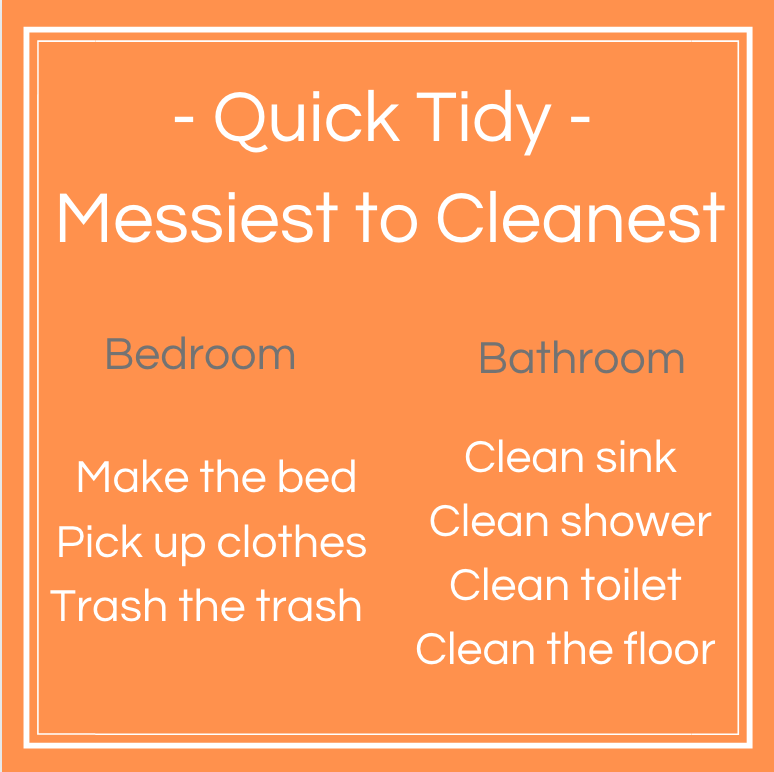Are you preparing a child to leave home? Enjoy these simple life hacks and easy ways to teach them the need-to-knows. Feel confident they can go out and live a meaningful, productive life, without the Mom guilt!
I often get questions from moms saying “HELP! My child is a senior, what am I supposed to have taught him and is it too late to start teaching?” I’ve had those same questions for myself. And the answer is, I don’t know, but after raising seven kids, I have a few ideas, some great life hacks, and the absolute surety that it’s NEVER too late.
I’ve spent plenty of time going back to the drawing table for my own kids studying, experimenting, tweaking, and through all that I found the 8 C’s that I needed to teach my own kids before they left home. Now, I offer them to you, with the clear caveat: you know best. You are you child’s mother, so go with your gut. Beyond that, whether it’s how to communicate, cook, clean, or get a car, I’ve got some tips to help you teach them in everyday ways and enjoy it!
The eight topics which were originally covered in my three-part series on the Balance reDefined Podcast and the short and sweet version found here are to cook, clean, car, cash, Christ, communicate, connect, and contribute. I love all of those C’s, because they are easy to remember so you can kind of finger through and go, “hey, did we do anything on that this week?”
You are probably already getting hives for feeling some anxiety, thinking “but I haven’t taught them anything”. In actuality, you have, you have probably taught a lot more than you realize because you are walking instructor for the good, the bad, or the ugly. Before getting into the C’s, I want to explain two important things.
First, when teaching your children, it does not matter if they listened. It does not matter if they slept through everything you shared. It does not matter if they rolled their eyes or slammed their doors. Did you teach them? Because if you taught them, you did your job. We did not force them, we just said, “Hey, I’m teaching, I’m sharing. I’m letting you know these are things that you need to know to go out into the real world” and they have their choice whether or not they wanted to listen.
That outcome is not your problem or your concern in the sense that of course, we want to produce wonderful, stellar contributing adults. Right? Absolutely. But don’t keep yourself up at night by saying, they chose not to listen to what I taught them. That was their choice.
Second, do not complicate this. Do not feel that suddenly you have to do a three-week summer camp on all of these skills you did not teach your child. Teach them in everyday ways. You can do this in daily life. It is just about being intentional and actionable. Have those moments to teach in everyday life in everyday ways. That is the important thing.
Wondering what life skills you might have forgotten? I have a mini-checklist for that. Email me at Hello@Conniesokol.com
The 8 C’s
Communication
If your child cannot look someone in the eye and have a functional, meaningful conversation, they are going to struggle.
We’ve seen it. Kids dealing with anxiety, not being able to hold professional conversations, not being able to have personal conversations. Consider what your child is going to do with a roommate, a coworker, a travel buddy, maybe with a humanitarian or a church mission companion. Everyone needs to be able to have personal and professional communication. This is so important for regular children because nowadays, the generations are five steps away from civility and courtesy and everyday conversation cues.
When teaching communication skills, I use the acronym GEAR with the cute slogan “GEAR up for communication.”
G – Greeting: When they walk into a room, they need to assess the situation, who is already talking, what is already happening, how do they insert yourself into this experience?
E – Eye Contact: Maintaining eye contact. It is okay to glance away and look at things, to look at their nose or eyebrows, but at least in the general area.
A – Ask-listen: If they have a question or need to make a request, they need to do so and then they need to listen. They need to learn to let someone finish their sentence and, and be able to let them have their say and then they can respond to whatever they said.
R – Respond: Finally, they need to respond. Whether it’s verbal or non-verbal, they have to have some kind of cue that says they are involved in what is happening and then, the verbal response of being able to say, yes, I understand what you’re saying or be able to clarify it.
Clean
A survey of the top issues among roommates shows that messy living habits are among the top three.
Although what one might consider messy and what others consider messy might be chalked up to a matter of opinion, there still should be a baseline. Talk about what a clean room looks like, whether they want to agree or disagree or not, there are some facts involved. They really do need to know how to clean a bedroom, clean a bathroom, and clean the kitchen.
Talk about the difference between personal and public spaces. They need to know how to do a quick tidy and regular weekly/bi-weekly clean.

There are just required chores to do in the house because they are part of a family. That is just all there is to it, and you decide what those are.
Set it up so that when they leave the home they have that kind of rhythm in their life and when it comes down, push comes to shove, they will know how to do just those basics.
Cash
An article in Forbes cited that the most common financial literacy problems for graduating seniors were some of the following: not knowing how to budget, not knowing how to spend less than they earn, not knowing how debt works, not knowing what an emergency fund is and why they need one and not knowing why they should invest.
It is important for them to know the difference between daily finances and future finances. They need to be able to create a budget, show them how to pay bills and do online banking.
This is what happens. From a young age, show them how it works. They will snore, they will roll their eyes. They’re not paying attention. But what I’ve done my job, so there you go to the next step and get them a debit card at a proper age. You’ll know when your child is ready for that. We start them at 16. I like them having a debit card that acts like a check, but without the danger of a check and it helps them to get used to how they run and track their money.
We want them to know how to balance and really use their finances in a way that’s going to be fun and functional so that they’ll sustain it. They’ll do it in a balanced way.
Cook
There are so many studies shown about the benefits of mealtime. It keeps kids from getting into drugs, having early teen pregnancy, having issues with communication, having hardship in being able to do their homework and schedule their lives.
What’s most important is that you have at least good, decent food in the house that people can partake up, right? Really important. But the second thing is that we create community and family time as much as possible around a meal. All of this happens because of a mealtime.

They have higher self-esteem, which is higher confidence, they have higher life skills and they just benefit and grow and bloom from having a regular mealtime. We get together three to four nights a week and then the other times I do it in groups as we do it with these two kids because these two have these events or this work schedule, and so we do it these ways. Just be creative in the way that you create that, but do make that a thing in your home. If you can, we do family meals together.
Consider what your expectations are for what you want them to know about cooking before they leave. Teaching cannot ever get too basic. Just double-check that they have those skills, keep if fun and teach them how to put it in their lives in a doable way. Choose five to ten recipes that you want them to know how to make.
I do a little recipe minor that I laminated. It’s for emergencies. Nobody ever hardly looks at it, but there have been times where they’ve actually had to pull that out and actually do give instructions on how to make scrambled eggs because that is the one life skill everyone needs to know. Scrambled eggs, toast. You’re done. It’s a meal. It’s a total meal.
Make it simple, make it fun and appealing, and make it matter. Make that time a time where you connect, you talk, you laugh, you, you disagree about stuff and it’s all over food. It’s a very Italian feeling, make it that kind of experience and they will continue that tradition as they move on. Even if it’s a little bit adjusted when they move to a different apartment or into a different place, they will keep that rhythm with them and I’ve seen that happen.
Christ
Studies again show that when they know that there is a higher power or something that is more than them, they are more altruistic, they are more compassionate, they’re more kind, they’re more aware of others, they are more courteous, they’re more civil.
Whatever your belief system is, remember just a spiritual approach, but it did not start with a C, so I am so sorry that just kept the whole eight C’s thing going, you just choose what works for you, whether it’s nature, whether it’s to find influence, whether it’s higher power, whatever it is I can tell you we need to give our kids that kind of base.
They’ve got to have something solid that is more than them, something that is above and beyond them. The blessings and the benefits just keep going on and on and on. The couple of things that I just want to quickly share with you about this are establish spiritual rhythms and create sacred spaces.
Spiritual rhythms could be, um, one of four things that I know that we use in our family. It comes from a talk about four cornerstones of a happy family. Mine includes prayer, a spiritual message, family night, and family fun. With these four cornerstones, I have seen the formation of a solid foundation, but again, do whatever feels comfortable for you.
Prayer: We have prayer morning and night. We make it very doable in our lives, but prayer is a bedrock. We know that that’s going to happen morning because that’s how we’re going to connect before they go out to the beyond and it’s how we’re going to pull it back again, kind of bookends for the day.
Spiritual message: We’ll do a spiritual thought; we’ll do a devotional. We’ll do something that someone learned today, a life principle that they’re tying back to a scriptural principle, whatever that looks like. We are sharing all the time, spiritual messages that help get that into their souls. Something that they can kind of use as a bedrock, as an anchor or something they can tie to.
Family night: This is a time that
you can plan on as a family. Could be family day, could be family morning,
could be family afternoon, whatever. Just family time, but we have family night
and that’s a time when we have some fun, but we also have like our family
council and that’s when we can bring up stuff that might need to change.
Family Fun: We’re doing games, we’re
doing bowling, we’re doing a Pride and Prejudice binge, we’re going hiking, whatever
that might be. We’re doing something fun and we’re making a memory. We’re big
on trips, we love taking trips together. We’re not big on doing like a ton on
the trips were not super big sightseers like we have to pack and everything
that we don’t. We’re not like that. We like to really go to places that we want
to be together. We want to experience a few things that are new. Take time,
relax, connect, laugh and eat as always.
How does that bring them back to Christ? Because those four cornerstones really bring us back to loving him, learning about him, and then rejoicing in what he’s given us, which is family. Because family is core and it doesn’t matter what that family looks like for you, what your family is, needs, nourishing. And that when we nourish our each other as a family, we are doing God’s work. We are doing what he wants us to do and bringing us closer to him. So as you probably would have guessed, and all of these things that I do, prayer and spiritual message and family night and fun, I am weaving in spiritual messages all the time of drawing them to him of how can we serve, how can we love, how can we be more like him and what we do.
I’ve talked about those spiritual rhythms, the sacred spaces, I’ve alluded to, finding spaces for those things to happen, those sacred spaces for prayer, for spiritual messages, for family night to happen. We know it’s going to happen around the kitchen table or it’s going to be on my bed or it’s going to be in the living room. We have this beautiful living space down there that’s just open and airy and light and we love to have that there. And fun, we know where those sacred spaces are going to be for fun. So something to consider when you’re looking at your family life and saying, how can we draw closer to Christ, to God, to a higher power, to divine influence? What can we do to help get that into their souls? It’s the small and simple things. It’s the small and simple spiritual rhythms and sacred spaces that they will turn to when they are in an apartment when they’re on a travel study abroad.
Connect
Everything that our life revolves around and everything that is meaningful always comes back to connection.
If we can help our kids know how to connect, we have been stellar parents. If they can only cook top ramen for dinner to totally fine because they know how to love and be loved. With connection, they need to be able to create and sustain fulfilling relationships. That’s the main goal of connection. That’s what we want to do and we want to do it in healthy ways, to reach out and make friends on a personal level and on a professional level we want to be able to network and business relationships and can do that in a way that’s natural and not manipulative or it’s not salesy.
Think about how someone feels when they’re working with you and then how can
you transfer that to your kids. Share those everyday moments. And that takes us
into the approach. Share those everyday moments with your kids. Share how
someone filled that need for you and how they went the extra mile. Share how
you did that for someone else. Even though you may feel like, oh, wait a minute
was a service and I don’t really want to talk about it. That extra mile is what
makes the difference, that win. What matters is the way we connect while we do
them and when we help our kids understand that they start to get a concept of
what a meaningful life looks like.
Car
The bottom line is transportation is everything. It’s freedom. It is mobility. It is how you’re going to get to your job, whatever that looks like.
When they are out and about in college, on a humanitarian or church mission, on
a study abroad, whatever it might be they need to know what to do when they
have transportation and when they don’t. Maybe it is their own transportation or
maybe it is the transportation of other’s.
When they don’t have any of their own, I like to teach the principle and the skill of get creative. In high school I did not want to ride the school bus and I had a friend who drove and so I would pay her gas money so that she could drive me to school. Now she was going there anyway, but it was a courtesy. Again, back to that win-win. Go the extra mile. I paid her gas money so that was like five bucks I think. So teach your kids, be creative about it. If they don’t have their own transportation, then who does and how can they make it a win win for them.
When it is time to get their own transportation, there are lots of different options so it doesn’t mean they have to have this expensive new car. In fact, I think it’s better when kids start out with something that isn’t amazing they learn to appreciate when they do get something amazing and they take good care of it. So, when they are doing something that is different that they’re going out and seeking, um, their own transportation, they know to look at some options, remember to teach them how to look up online, how to vet good cars, check the blue book value, and talk about their contribution.
Contribute
All of the C’s are important, but this teaching and this concept, especially in our society today, where entitlement is so rampant. It’s such a part of life that they don’t even hear themselves say it and it floors me and I’m sure I do the same thing and I’m just not aware of it. I just think our generation was just so much more aware of, wow, this when, when we need to earn something, what can we do to do that?
One of the first things that we can do, is help them determine if their contribution is their personal purpose and then their public purpose. Like what are they doing out there to help others? A lot of times those two should be and probably will be in sync. Their personal purpose will be something that they can share and do for others.
They can make a difference and what kind of a plan they can make to start just start because if their life is purpose-driven and purpose fulfilling, then they are going to feel that peace and that love and that joy and they’re going to help each other and help others all along the way. Whether it’s a roommate or whether it’s on a smaller scale at work or maybe it’s a bigger scale, global scale, whatever that is.
Just putting these things into approaches in small everyday ways and maybe in some bigger ways that make sense for you and your family, but making that a part of your training for your children. With awareness and intention, you can do choose an action and that can be a very simple conversation. Three minutes and you will have taught a life skill and created that connection.
Think about those personal connecting ways you can teach your children those life skills so that not only are you teaching them skills to make them a future stellar adult, but you’re creating that meaningful connection all along the way.
Want more details about the 8 C’s? Listen to the Podcasts below.


